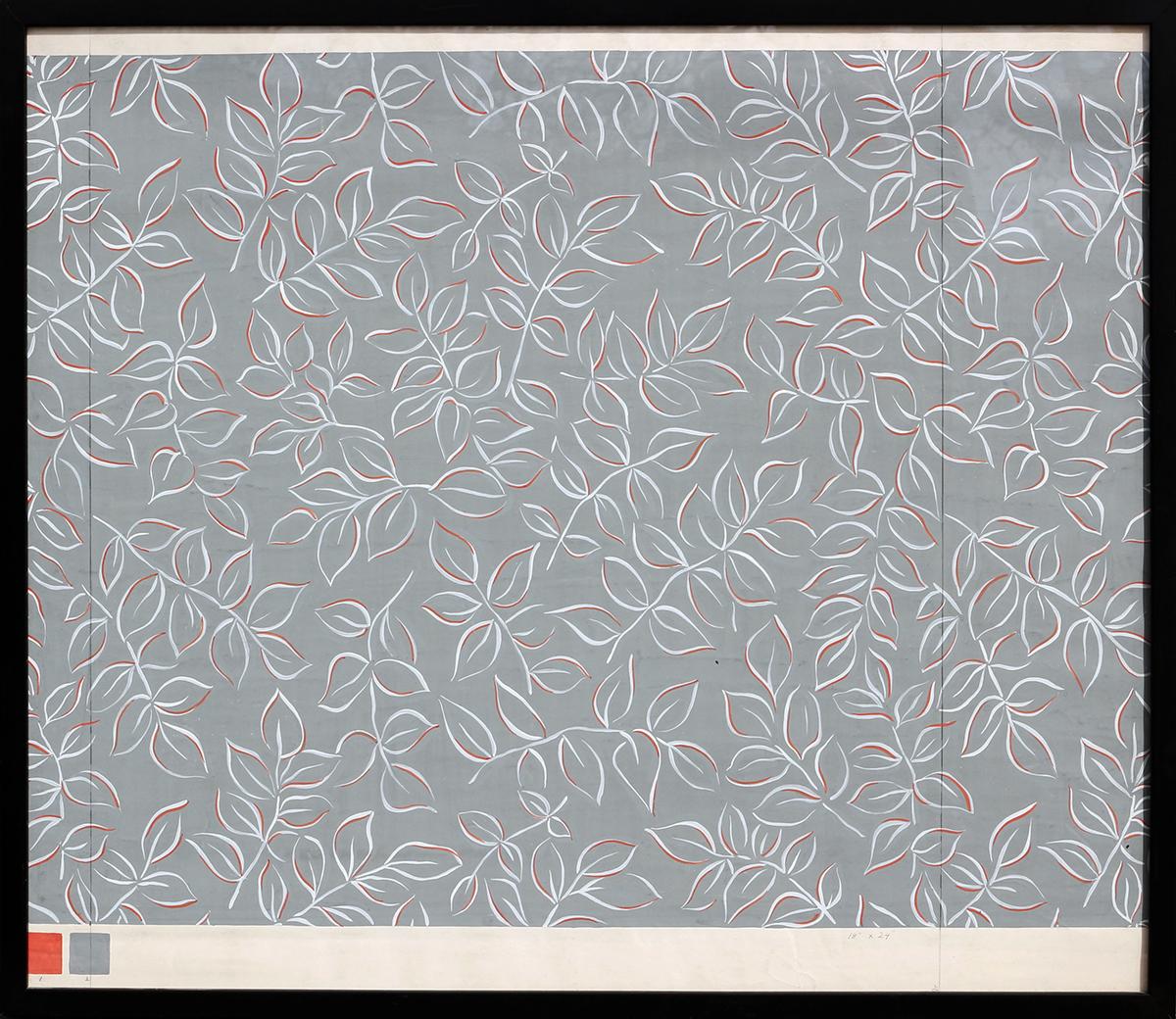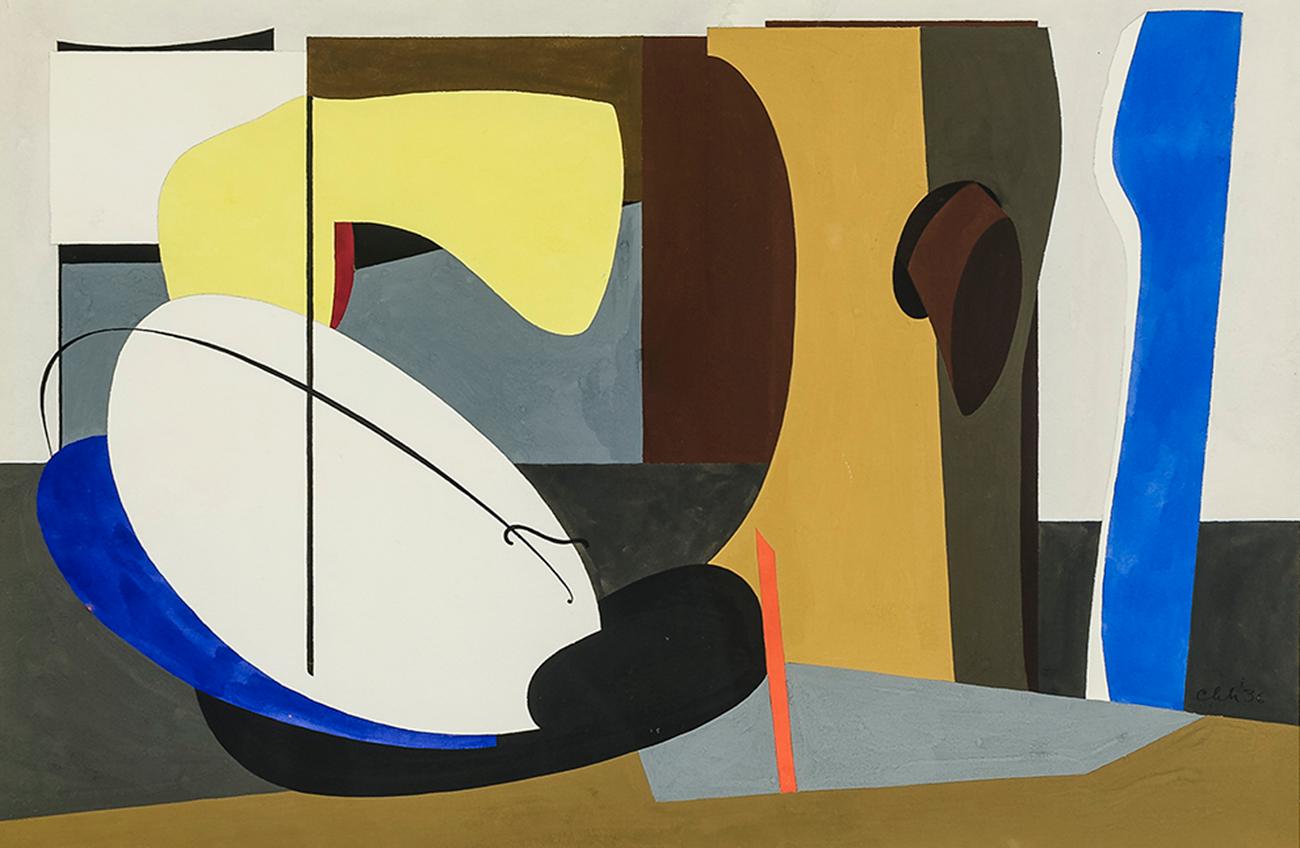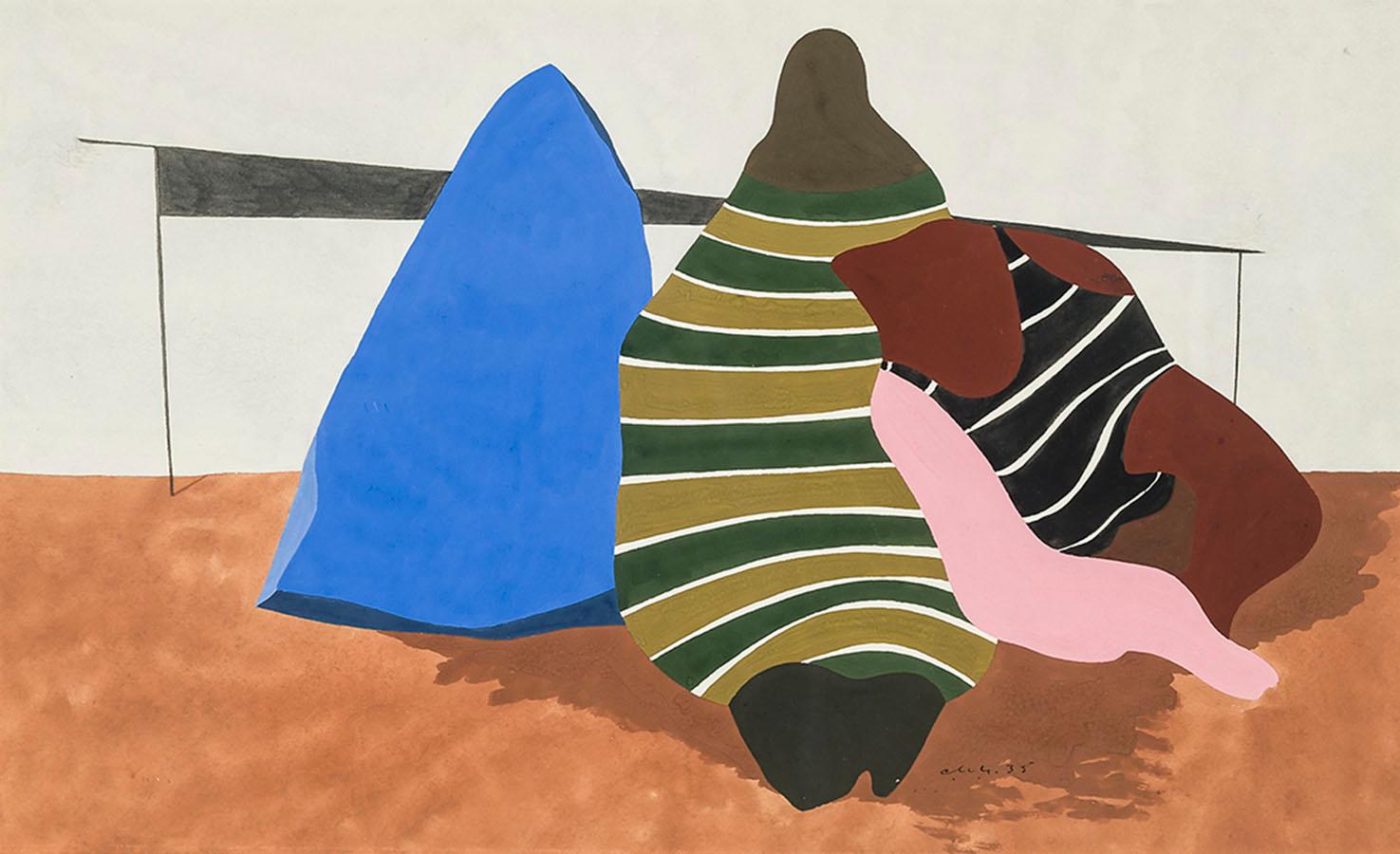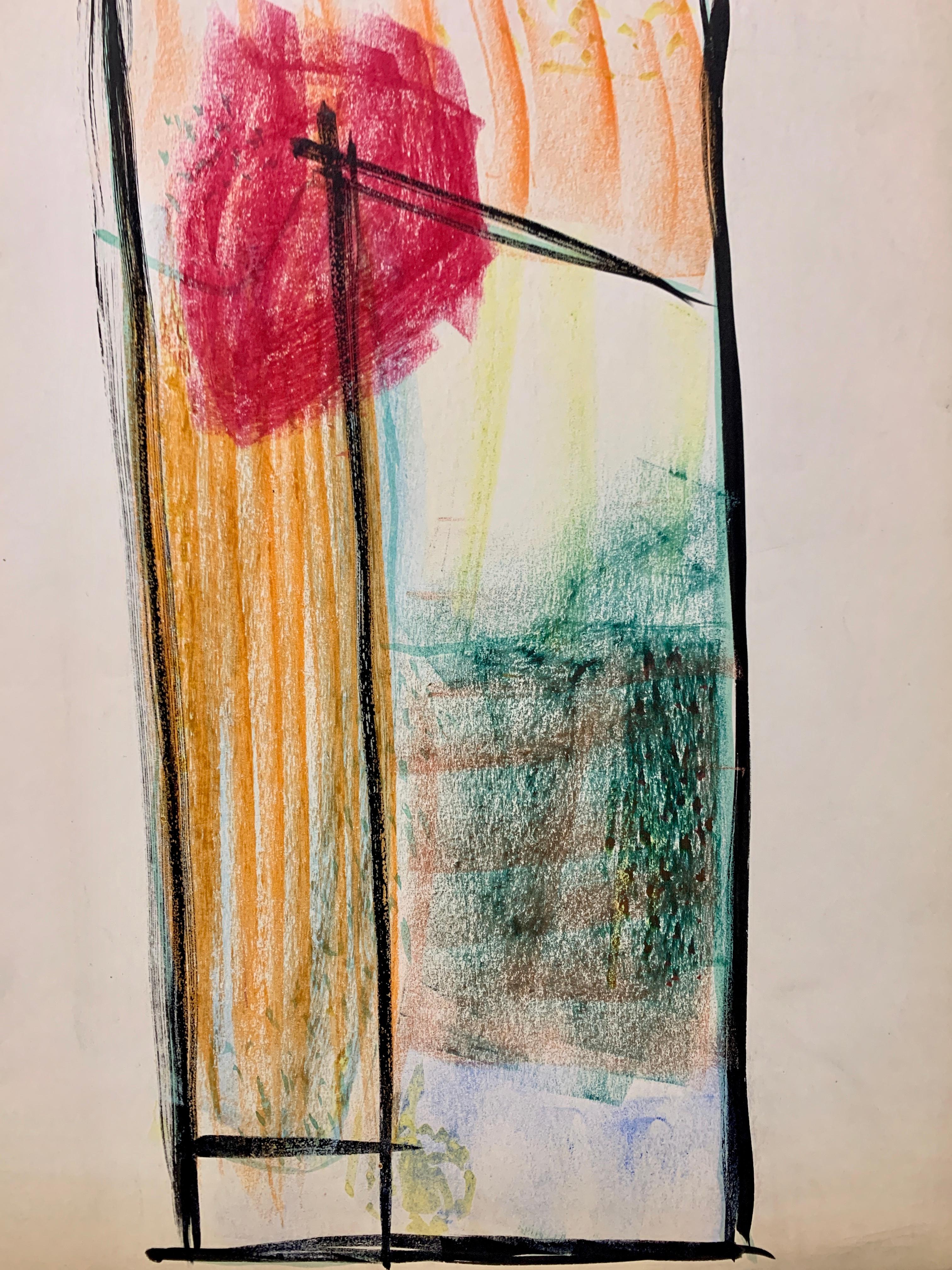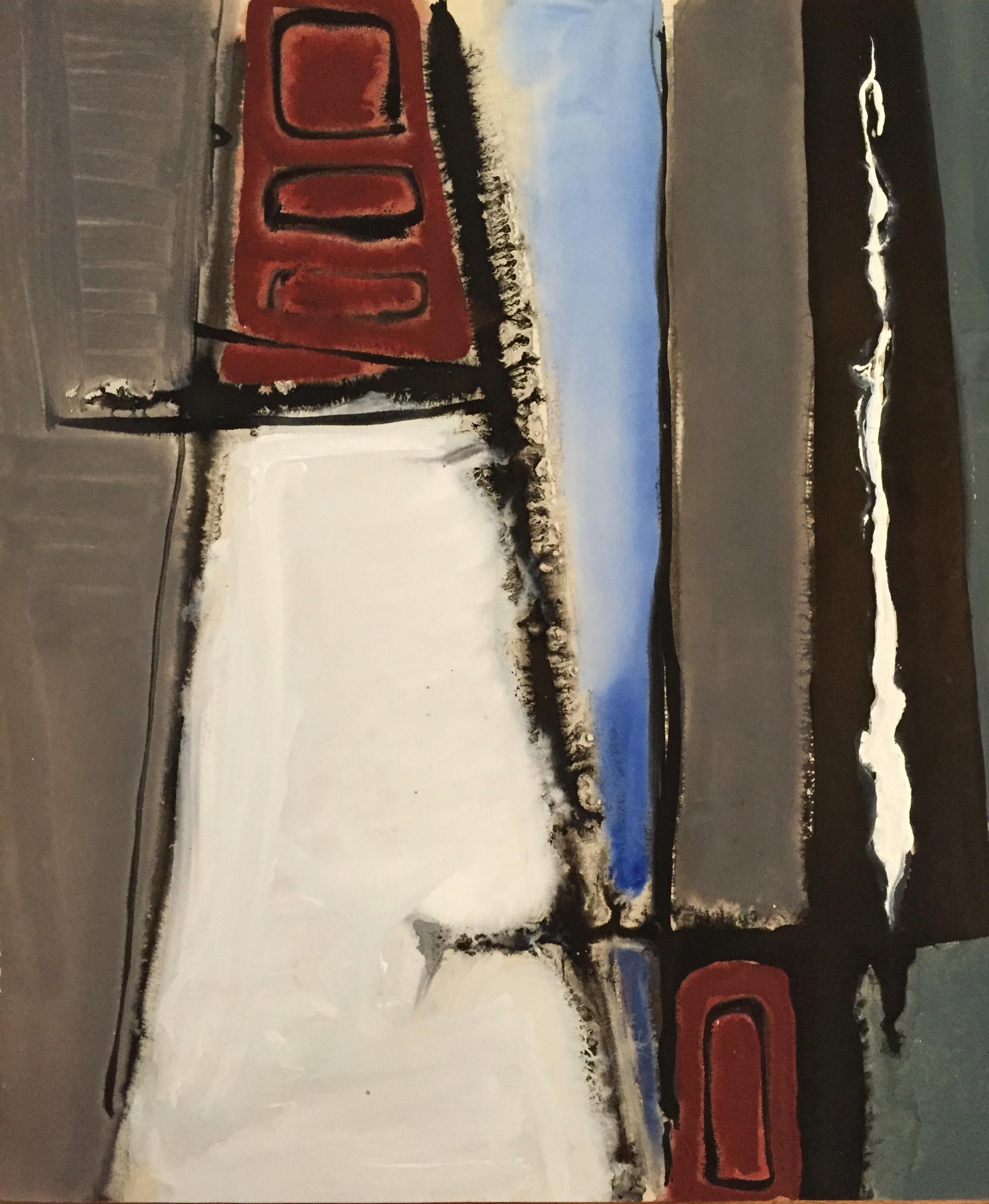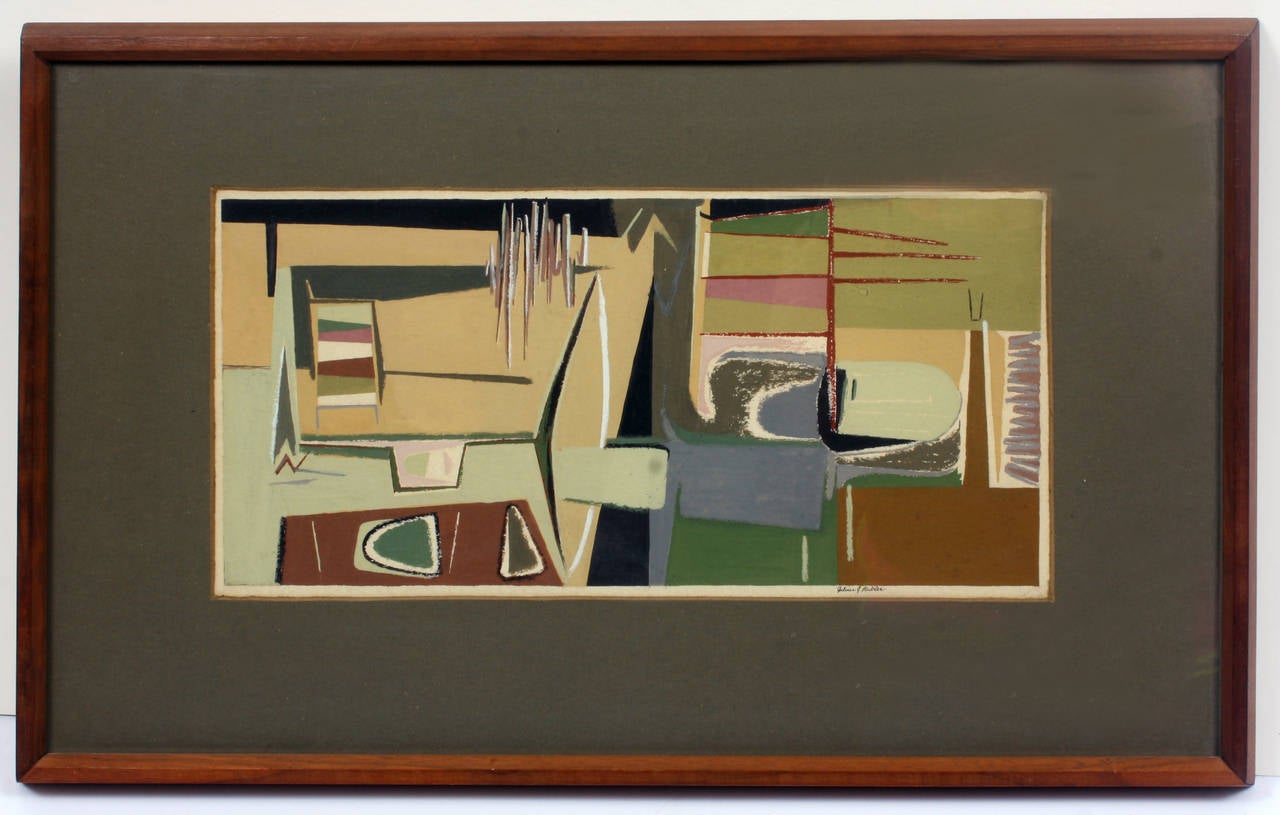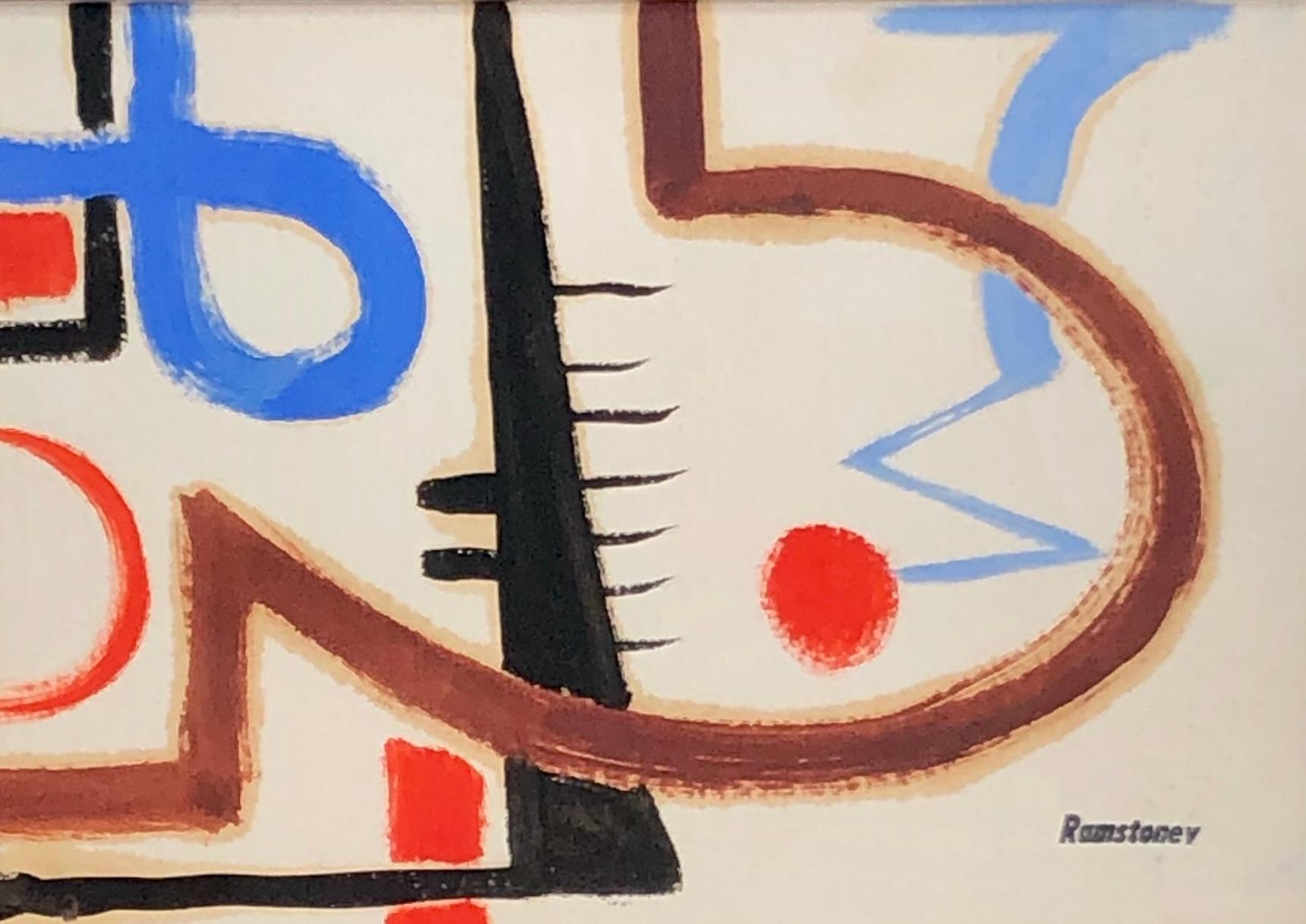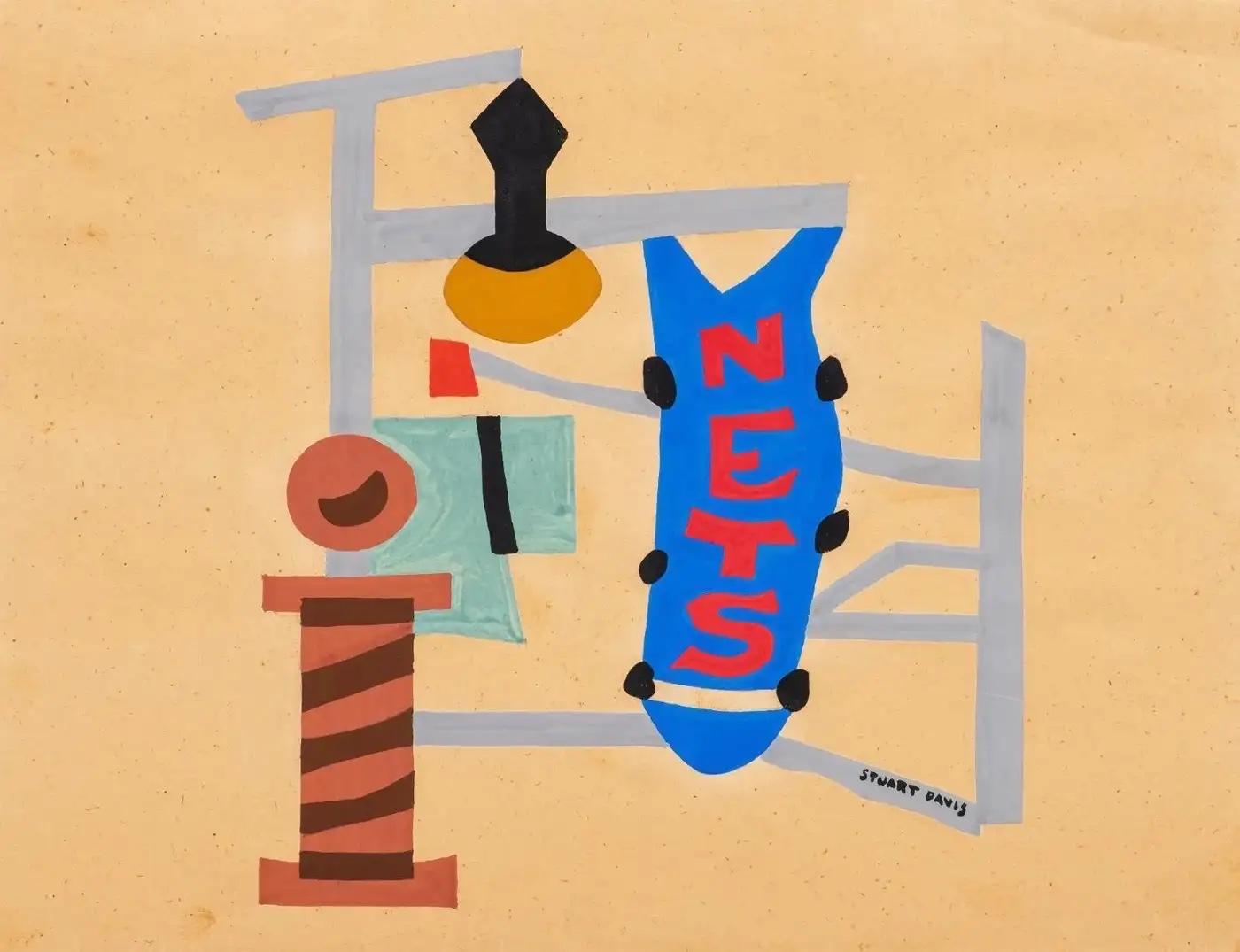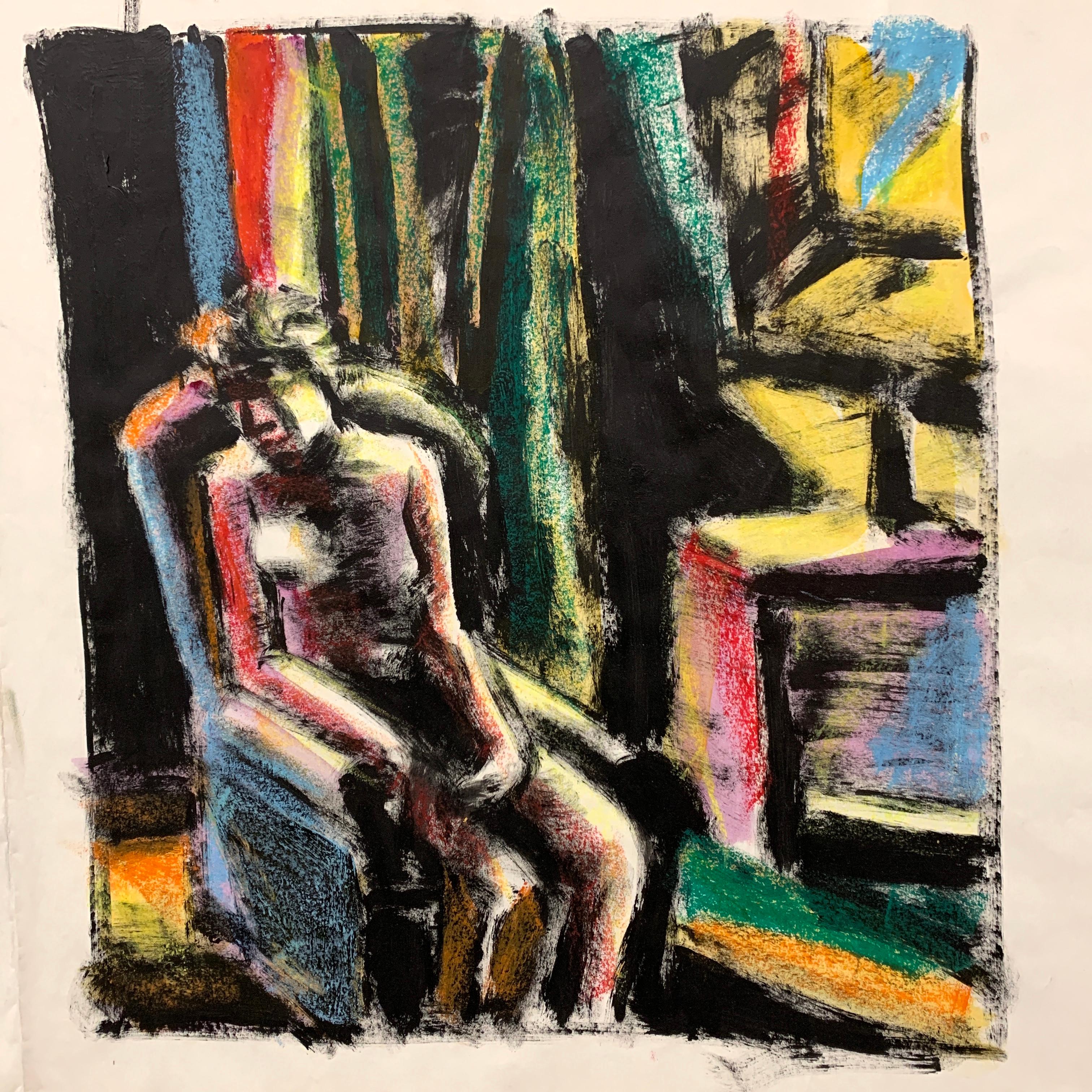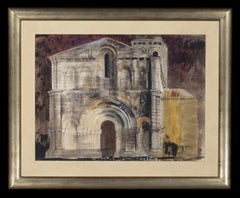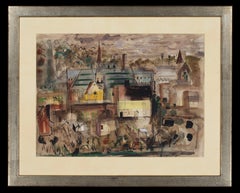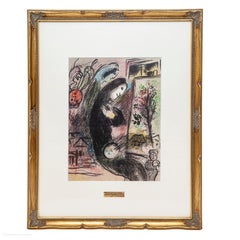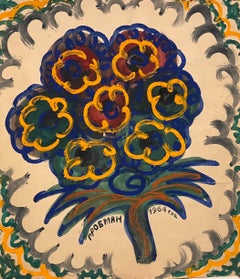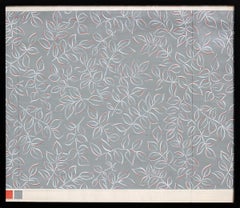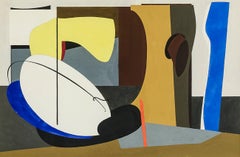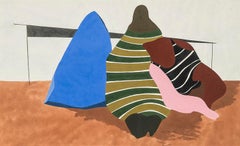
Peter Lanyon, Winter Landscape, Anticoli Corrado, Watercolor, Gouache, 1953
View Similar Items
Want more images or videos?
Request additional images or videos from the seller
1 of 11
Peter LanyonPeter Lanyon, Winter Landscape, Anticoli Corrado, Watercolor, Gouache, 19531953
1953
About the Item
- Creator:Peter Lanyon (1918 - 1964)
- Creation Year:1953
- Dimensions:Height: 12.6 in (32 cm)Width: 14.18 in (36 cm)Depth: 0.79 in (2 cm)
- Medium:
- Movement & Style:
- Period:
- Condition:
- Gallery Location:Eversholt, GB
- Reference Number:1stDibs: LU146628105992
About the Seller
No Reviews Yet
Vetted Professional Seller
Every seller passes strict standards for authenticity and reliability
1stDibs seller since 2021
Typical response time: 8 hours
Authenticity Guarantee
In the unlikely event there’s an issue with an item’s authenticity, contact us within 1 year for a full refund. DetailsMoney-Back Guarantee
If your item is not as described, is damaged in transit, or does not arrive, contact us within 7 days for a full refund. Details24-Hour Cancellation
You have a 24-hour grace period in which to reconsider your purchase, with no questions asked.Vetted Professional Sellers
Our world-class sellers must adhere to strict standards for service and quality, maintaining the integrity of our listings.Price-Match Guarantee
If you find that a seller listed the same item for a lower price elsewhere, we’ll match it.Trusted Global Delivery
Our best-in-class carrier network provides specialized shipping options worldwide, including custom delivery.More From This Seller
View AllJazennes 1967
By John Piper CH
Located in Eversholt, Bedfordshire
JOHN PIPER (1903-1992)
JAZENNES, 1967
Watercolour, pen, ink & gouache on paper
56x75cm
Signed & titled and dated lower right
From the mid 1950s, Piper travelled frequently in France...
Category
1960s Abstract Landscape Paintings
Materials
Watercolor, Gouache
Price Upon Request
Coalport Shropshire, 1957
By John Piper CH
Located in Eversholt, Bedfordshire
JOHN PIPER (1903-1992)
COALPORT SHROPSHIRE, 1957
Signed lower right
57x78cm
PROVENANCE :
Private Collection
Paisnel Gallery
Private Collection
Comprehensive cataloguing available on ...
Category
1950s Abstract Landscape Paintings
Materials
Watercolor, Gouache
Price Upon Request
Watercolour Estuary Landscape Victorian
Located in Eversholt, Bedfordshire
just purchased more information to follow
Cypher lower right
Within a grey mount, 14cm high, 28cm long
The gilded cavetto moulded frame 28 cm high, 41 cm long, 3.5cm deep
Category
1850s Victorian Landscape Drawings and Watercolors
Materials
Watercolor
L'inspiré Self Portrait Marc Chagall Valentina Vava Lithograph 1963 Mourlot 398
By Marc Chagall
Located in Eversholt, Bedfordshire
Inspiration or L'inspiré - The artist and his wife, self-portrait.
This is a self-portrait of the great artist, depicting him as lost in thought before one of his paintings, which is apparently related to his home country Russia, as suggested by the small figure in the lower right of the work. Chagall’s wife Valentina (“Vava”), who was also from Russia, is looking over his shoulder, full of longing. The small surreal elements that are characteristic of Chagall’s paintings are also present here: the silhouettes of the houses that seems to stick out of the painting and a figure with a flute or trombone standing on its head.
Chagall Lithographe, Volume II of the catalogue raisonné of Chagall's lithographic work, see Mourlot 398, 1957-1962, Paris 1963, imprinted by Imprimerie Mourlot for the publisher André Sauret. A lithographic plate from the catalog that was published in 10,000 copies.
Condition : Excellent
Set inside a cream mount bearing brass cartellino
Visible sheet size length 23cm, Height 31.50cm
In a carved and gilded frame
Frame size Length 44cm, Height 55.5cm
The reverse with a paper label in Japanese
Provenance : Private Collection, purchased with Lovers in Grey
Category
1960s Modern Figurative Prints
Materials
Lithograph
16. Easton, Portland, Dorset: St George Reforne, an 18th Century Church Quarries
By John Piper CH
Located in Eversholt, Bedfordshire
John Piper CH 1903–1992
16. Easton, Portland, Dorset: St George Reforne, an 18th Century Church among the Quarries
Numbered 2/70 lower left and si...
Category
1960s Modern Landscape Prints
Materials
Black and White
Marc Chagall Still Life with Fruits 1957 Original Lithograph Mourlot 205
By Marc Chagall
Located in Eversholt, Bedfordshire
Surrealist composition with a dog, figure, cockerel floating above the still life
In a cream mount, visible sheet length 19.50cm, height 22.50cm
Within a black and silvered moulded ...
Category
1950s Modern Animal Prints
Materials
Lithograph
You May Also Like
Post Soviet Nonconformist Avant Garde Russian Israeli Gouache Painting Grobman
By Michail Grobman
Located in Surfside, FL
MIchail Grobman
Gouache and watercolor on paper
Hand signed Lower Left and Dated 1964.
Described inn Cyrillic Russian verso.
Dimensions: L:13.25" W: 11.75".
Michail Grobman (Russian: Михаил Гробман, Hebrew: מיכאיל גרובמן, born 1939) is an artist and a poet working in Israel and Russia. He is father to Hollywood producer Lati Grobman and Israeli architect Yasha Jacob Grobman.
Biography
1939 – Born in Moscow.
1960s – Active member of The Second Russian Avant-Garde movement in the Soviet Union.
1967 – Member of Moscow Artists Union.
1971 – Emigrates to Israel and settles in Jerusalem.
1975 – Founded the Leviathan group and art periodical (in Russian).
Since 1983, he lives and works mainly in Tel Aviv.
Awards
In 2001, Grobman was a co-recipient of the Dizengoff Prize for Painting.
Solo exhibitions
2007 – Last Skies, Loushy & Peter Art & Projects, Tel Aviv (cat. text: Marc Scheps)
2006 – Creation From Chaos to Cosmos, Bar-David Museum of Fine Art and Judaica, Kibbutz Baram (cat. text: Sorin Heller)
2002 – The Last Sky, installation, Tsveta Zuzoritch pavilion, Belgrad (cat. text: Irina Subotitch)
1999 – Mikhail Grobman: Works 1960–1998, The State Russian Museum, St. Petersburg (cat. texts: Evgeniya Petrova, Marc Scheps, Lola Kantor-Kazovsky, Michail German)
Michail Grobman was born in Moscow. He grew up writing poetry, essays and literary prose. In the 1960s, he was active in the Second Russian Avant-garde movement in the Soviet Union. In 1971, he immigrated to Israel. In 1975, he established the Leviathan school together with Avraham Ofek and Shmuel Ackerman, seeking to combine symbolism, metaphysics and Judaism in an all-inclusive “national style.”
Grobman’s lithograph work employs images and symbols from Jewish mysticism and Kabbalah. His paintings incorporate texts in Russian and Hebrew. In addition to his artistic endeavors, he writes about art and aesthetics. The group combined conceptual art and "land art" with Jewish symbolism. Of the three of them Avraham Ofek had the deepest interest in sculpture and its relationship to religious symbolism and images. In one series of his works Ofek used mirrors to project Hebrew letters, words with religious or cabbalistic significance, and other images onto soil or man-made structures. In his work "Letters of Light" (1979), for example, the letters were projected onto people and fabrics and the soil of the Judean Desert. In another work Ofek screened the words "America", "Africa", and "Green card" on the walls of the Tel Hai courtyard during a symposium on sculpture
Part of the generation of emigre Russian artists, many Jewish, that included Yuri Kuper, Komar and Melamid, Eduard Steinberg, Erik Bulatov, Viktor Pivovarov, Vladimir Yankilevsky, Ilya Kabakov and Grisha Bruskin.
Date of Birth: 1939, Moscow
1960s Active member of The Second Russian Avant Garde
1967 Member of the Moscow Painters Association
1971 Immigrated to Israel and settled in Jerusalem
1975 Founded the Leviathan group and art periodical (in Russian)
Since 1983 Lives and works in Tel Aviv
.
Selected Solo Exhibitions:
2002 Pavilion Zveta Zuzovich, "The Last Sky", Belgrad (cat: Irena Subotitch)
1999 The State Russian Museum, ST. Petersburg
1998 "Picture = Symbol + Concept", Herzliya Museum of Art, Herzliya
1995 "Password and Image", University Gallery, Haifa University
1990 Tova Osman Gallery, Tel Aviv
1989 "The Beautiful Sixties in Moscow", The Genia Schreiber University Art Gallery, Tel Aviv University (with llya Kabakov; cat. text: Mordechai Omer]
Spertus Museum, Chicago
Beit Rami and Uri Nechushtan, Ashdot Yaacov (leaflet)
1972 Nora Gallery, Jerusalem 1973 - Negev Museum, Beer Sheva
1971 Tel Aviv Museum of Art (cat. text: Haim Gamzu)
1966 Mos-lng-Projekt, Moscow
1965 Artist's House, Moscow
Energy Institute, Moscow
History Institute, Moscow
Usti-nad-Orlicy Theatre,Czechoslovakia (leaflet text: Dushan Konetchni)
1959 Mukhina Art Institute, Leningrad
.
Selected Group Exhibitions:
2003 "Yes do yourself...", Regeneration of Judaism in Israeli art, Zman Omanut Tel Aviv (cat: Gideon Ofrat)
1999 "Russian post-war avantgarde", The Trajsman Collection in the State Russian Museum, St. Petersburg Tretjakov National Gallery, Moscow (cat. text: Yevgenij Barabanov, John Bolt...
Category
1960s Modern Abstract Paintings
Materials
Paper, Watercolor, Gouache
Modern Grey and Orange Geometric Abstract Leaf Pattern Painting
By John Little
Located in Houston, TX
Modern grey and white geometric abstract leaf pattern composition with orange accents by textile designer John Little. The work was created as a proposed design for a wallpaper and features the original color codes in the front lower left corner. Currently hung in a solid black frame with a large white margin.
Dimensions Without Frame: H 27.13 in. x W 31.5 in.
Artist Biography: A painter and textile designer, John Little is best known for gestural works filled with boldly explosive color that reflect the influences of his teacher Hans Hofmann and for his involvement in the Abstract Expressionist movement in East Hampton, where he moved in the late 1940s. In East Hampton Little congregated with Jackson Pollock, Lee Krasner, and the other artists who were the leading innovators in the New York School.
John Little was born in Sanford, Alabama. He left home at the age of fourteen to become an artist, and moved to Buffalo, New York, in 1923. After spending a year working as a stevedore on the docks to save money, he enrolled at the Buffalo Fine Arts Academy and developed an interest in singing. In 1927 he moved to New York City where he continued his vocal work and studied operatic literature. He also became involved in textile design, opening his own store in 1920, called John Little Studios: Fabric and Wallpaper Design. He ran the store until 1950.
In 1933 John Little resumed his painting studies at the Art Students League in New York under the guidance of George Grosz (1893-1959). The following year he made his first visit to East Hampton, Long Island, which he would eventually call home. Later in the decade, he traveled to Paris where he became familiar with European modernism. On his return to America, he taught textile design at the Pratt Institute in Brooklyn. He hired Josephine Watkins to work for him; she later became his wife. Little's textile store and teaching job gave him a financial security that was rare during the Depression, and he never found it necessary to find employment with the Works Progress Administration. At the end of the decade, John Little studied with Hans Hofmann (1880-1966) in New York and Provincetown. Little was greatly influenced by Hofmann, particularly by his views on color theory.
In 1942 John Little joined the Navy as an aerial photographer. In the late 1940s he purchased a rundown house on Three Mile Harbor...
Category
Early 20th Century Modern Abstract Drawings and Watercolors
Materials
Paper, Gouache
Untitled
By Charles Houghton Howard
Located in New York, NY
Charles Houghton Howard was born in Montclair, New Jersey, the third of five children in a cultured and educated family with roots going back to the Massachusetts Bay colony. His father, John Galen Howard, was an architect who had trained at M.I.T. and the École des Beaux-Arts in Paris and apprenticed in Boston with Henry Hobson Richardson. In New York, the elder Howard worked for McKim, Mead and White before establishing a successful private practice. Mary Robertson Bradbury Howard, Charles’s mother, had studied art before her marriage. John Galen Howard moved his household to California in 1902 to assume the position of supervising architect of the new University of California campus at Berkeley and to serve as Professor of Architecture and the first Dean of the School of Architecture (established in 1903). The four Howard boys grew up to be artists and all married artists, leaving a combined family legacy of art making in the San Francisco Bay area that endures to this day, most notably in design, murals, and reliefs at the Coit Tower and in buildings on the Berkeley campus.
Charles Howard graduated from the University of California at Berkeley in 1921 as a journalism major and pursued graduate studies in English at Harvard and Columbia Universities before embarking on a two-year trip to Europe. Howard went to Europe as a would-be writer. But a near-religious experience, seeing a picture by Giorgione in a remote town outside of Venice, proved a life-altering epiphany. In his own words, “I cut the tour at once and hurried immediately back to Paris, to begin painting. I have been painting whenever I could ever since” (Charles Howard, “What Concerns Me,” Magazine of Art 39 [February 1946], p. 63). Giorgione’s achievement, in utilizing a structured and rational visual language of art to convey high emotion on canvas, instantly convinced Howard that painting, and not literature, offered the best vehicle to express what he wanted to say. Howard returned to the United States in 1925, confirmed in his intent to become an artist.
Howard settled in New York and supported himself as a painter in the decorating workshop of Louis Bouché and Rudolph Guertler, where he specialized in mural painting. Devoting spare time to his own work, he lived in Greenwich Village and immersed himself in the downtown avant-garde cultural milieu. The late 1920s and early 1930s were the years of Howard’s art apprenticeship. He never pursued formal art instruction, but his keen eye, depth of feeling, and intense commitment to the process of art making, allowed him to assimilate elements of painting intuitively from the wide variety of art that interested him. He found inspiration in the modernist movements of the day, both for their adherence to abstract formal qualities and for the cosmopolitan, international nature of the movements themselves. Influenced deeply by Surrealism, Howard was part of a group of American and European Surrealists clustered around Julien Levy. Levy opened his eponymously-named gallery in 1931, and rose to fame in January 1932, when he organized and hosted Surrealisme, the first ever exhibition of Surrealism in America, which included one work by Howard. Levy remained the preeminent force in advocating for Surrealism in America until he closed his gallery in 1949. Howard’s association with Levy in the early 1930s confirms the artist’s place among the avant-garde community in New York at that time.
In 1933, Howard left New York for London. It is likely that among the factors that led to the move were Howard’s desire to be a part of an international art community, as well as his marriage to English artist, Madge Knight...
Category
20th Century American Modern Abstract Drawings and Watercolors
Materials
Paper, Gouache, Graphite
Untitled
By Charles Houghton Howard
Located in New York, NY
Charles Houghton Howard was born in Montclair, New Jersey, the third of five children in a cultured and educated family with roots going back to the Massachusetts Bay colony. His father, John Galen Howard, was an architect who had trained at M.I.T. and the École des Beaux-Arts in Paris and apprenticed in Boston with Henry Hobson Richardson. In New York, the elder Howard worked for McKim, Mead and White before establishing a successful private practice. Mary Robertson Bradbury Howard, Charles’s mother, had studied art before her marriage. John Galen Howard moved his household to California in 1902 to assume the position of supervising architect of the new University of California campus at Berkeley and to serve as Professor of Architecture and the first Dean of the School of Architecture (established in 1903). The four Howard boys grew up to be artists and all married artists, leaving a combined family legacy of art making in the San Francisco Bay area that endures to this day, most notably in design, murals, and reliefs at the Coit Tower and in buildings on the Berkeley campus.
Charles Howard graduated from the University of California at Berkeley in 1921 as a journalism major and pursued graduate studies in English at Harvard and Columbia Universities before embarking on a two-year trip to Europe. Howard went to Europe as a would-be writer. But a near-religious experience, seeing a picture by Giorgione in a remote town outside of Venice, proved a life-altering epiphany. In his own words, “I cut the tour at once and hurried immediately back to Paris, to begin painting. I have been painting whenever I could ever since” (Charles Howard, “What Concerns Me,” Magazine of Art 39 [February 1946], p. 63). Giorgione’s achievement, in utilizing a structured and rational visual language of art to convey high emotion on canvas, instantly convinced Howard that painting, and not literature, offered the best vehicle to express what he wanted to say. Howard returned to the United States in 1925, confirmed in his intent to become an artist.
Howard settled in New York and supported himself as a painter in the decorating workshop of Louis Bouché and Rudolph Guertler, where he specialized in mural painting. Devoting spare time to his own work, he lived in Greenwich Village and immersed himself in the downtown avant-garde cultural milieu. The late 1920s and early 1930s were the years of Howard’s art apprenticeship. He never pursued formal art instruction, but his keen eye, depth of feeling, and intense commitment to the process of art making, allowed him to assimilate elements of painting intuitively from the wide variety of art that interested him. He found inspiration in the modernist movements of the day, both for their adherence to abstract formal qualities and for the cosmopolitan, international nature of the movements themselves. Influenced deeply by Surrealism, Howard was part of a group of American and European Surrealists clustered around Julien Levy. Levy opened his eponymously-named gallery in 1931, and rose to fame in January 1932, when he organized and hosted Surrealisme, the first ever exhibition of Surrealism in America, which included one work by Howard. Levy remained the preeminent force in advocating for Surrealism in America until he closed his gallery in 1949. Howard’s association with Levy in the early 1930s confirms the artist’s place among the avant-garde community in New York at that time.
In 1933, Howard left New York for London. It is likely that among the factors that led to the move were Howard’s desire to be a part of an international art community, as well as his marriage to English artist, Madge Knight...
Category
20th Century American Modern Abstract Drawings and Watercolors
Materials
Paper, Watercolor, Gouache, Graphite
1950s "Red Sun" Mid Century Abstract Art Students League NYC
By Donald Stacy
Located in Arp, TX
Donald Stacy
"Red Sun"
c.1950s
Gouache and oil pastel on paper
13.75" x 17" unframed
Unsigned
Came from artist's estate
*Custom framing available for additional charge. Please expect framing time between 3-5 weeks.
Donald Stacy (1925-2008) New Jersey
Studied: Newark School of Fine Art
The Art Students League...
Category
Mid-20th Century American Modern Abstract Drawings and Watercolors
Materials
Paper, Oil Pastel, Gouache
'Cubist Still Life', Italian School (circa 1940s)
Located in London, GB
'Cubist Still Life', gouache on paper, from the Italian School of artists (circa 1940s). Surely this very attractive piece was inspired by Juan Gris (1887-1927) and Georges Braque's ...
Category
1940s Modern Abstract Paintings
Materials
Paper, Gouache
$1,320 Sale Price
20% Off

